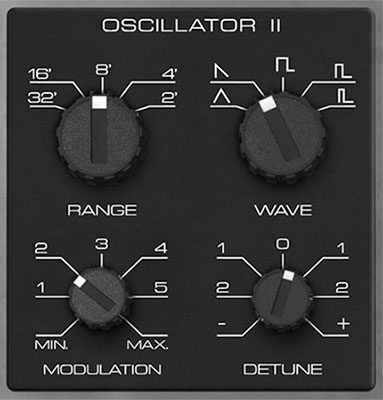Atomika includes two oscillators. Their controls are mostly similar, but different enough that we'll go over each individually, because online-doc ink is free!

Range- Coarsely sets the signal generator pitch range in octaves. These are at standard organ footage settings of 32', 16', 8', 4', and 2'.
Wave- This sets the basic oscillator waveform, including triangle, ramp, square, wide pulse, or narrow pulse.
Modulation- Sets the amount of modulation received from the Modulator in the upper-left corner. This is affected by the Mod Wheel switch in the Modulator section; for more info see the Modulator section.
Osc II FM- Sets the amount of modulation received from Oscillator II. Unlike typical low-frequency oscillator modulation (like the kind produced by the Modulator section) where the modulation sweep is clearly audible (imagine vibrato or tremolo), when pitch is modulated with an audio-range range oscillator, the modulation sweep is far too fast to be heard. This results in clangorous metallic sounds that can resemble ring modulation, bell tones, or the fabulous Yamaha FM digital synths of the 80s.
Oscillator II
Oscillator II is largely the same as Oscillator I with a few minor difference.

Range- Coarsely sets the signal generator pitch range in octaves. These are at standard organ footage settings of 32', 16', 8', 4', and 2'.
Wave- This sets the basic oscillator waveform, including triangle, sawtooth, square, wide pulse, or narrow pulse.
Modulation- Sets the amount of modulation received from the Modulator in the upper-left corner. This is affected by the Mod Wheel switch in the Modulator section; for more info see the Modulator section.
Detune- This can be used to fatten dual oscillator patches by detuning a small amount, or for "building-in" musical intervals. Its range is up or down a fifth.
Range- Coarsely sets the signal generator pitch range in octaves. These are at standard organ footage settings of 32', 16', 8', 4', and 2'.